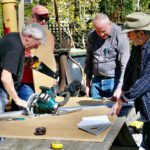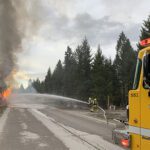Home »

Accident fatalities happen for more than one reason
 “Perceptions,” by Gerry Warner
“Perceptions,” by Gerry Warner
Op-Ed Commentary
Want to stay alive this winter?
If you do, I strongly suggest reading the following or you might end up like my wife and I two weeks ago, hanging upside down from your seatbelts after losing control of your vehicle while driving straight down a perfectly straight road.
After researching and talking to experts in the field, I think I know why my hitherto reliable 2000 Ford Explorer, with 415,000 km on the odometer went careening off Highway 3/95 just south of Moyie Dec. 30 and deposited us about 20 feet short of the railway tracks with a train going by.
It wasn’t speed, at least not directly. I was driving well below the speed limit because of the slushy road, but despite that I was obviously driving too fast for the conditions or I wouldn’t have spun out of control heading for the tracks. That brings up the Holy Mantra of winter driving, in the Kootenays and elsewhere. Slow down for God’s sake!
Slowing down is not rocket science. On winter roads you must drive according to the conditions. Yet how many of us do it all the time? Not enough for sure. But several other factors are involved too. I had MS (Mud and Snow) tires on my wheels with the snowflake certifying they were top of the line and I even had 50-pound sacks of sand over my rear wheels for extra traction. But I still slid like a child on a water slide.
Why, you may well ask.
Well, for starters, my winter tires were three-years-old. With big lugs on the tread, they looked pretty good to my casual glance before they were put on. However, after the crash, it was pointed out to me that my tires were well-worn and “cupped” on the inside which escaped my glance.
Cupping occurs for several reasons: worn out suspension (shocks and struts), wheels out of balance or not aligned properly, uneven tread etc. Solution? Get thee to a tire shop and don’t hesitate to buy new ones if recommended. You could also consider studded tires, which have metal steel pieces embedded into the tread providing more traction on ice, but not great on loose snow.
Studded tires also eat pavement and can only be used seasonally by law. However, you can also buy tires with walnut shells embedded in the rubber. No kidding! They give extra traction on ice too and aren’t so hard on pavement.
But I could have had the best tires in the world that fateful day and still slid. Here are a few key reasons why.
I slid was just south of Moyie where drivers start accelerating, which tends to polish any ice remaining on the road. My vehicle was rear-wheel drive, not as good as front wheel drive or all-wheel drive and then I hit black ice under the slush, and in an instant, I was hydro-planning totally out of control. That’s a recipe for injury or death. Luckily for my wife and I it was the former rather than the latter and it could happen to anybody.
Another factor pointed out to me by my Freightliner tow truck driver is that roads in our region are subject to all sorts of micro-climates which results in extremely “spotty” road conditions. The road can be perfectly safe one moment but covered with black ice and dangerous less than a minute later. Once again, the best thing to do is to slow down and reduce the odds against you.
This brings up an extremely relevant experience I had on Highway 95A about 15 years ago just south of Marysville.
Mainroad had applied a chemical to the road, which resulted in four inches of gunky, brown slush on the road. I had crossed the tracks and was heading into a curve when I met a Mainroad sanding truck coming towards me with its blade up and when we met – kerrplop – and all the lights went out as a humongous blob of slush landed on my windshield completely blocking my view of the highway.
Frantically, I reached for the wiper button while at the same time steering towards the edge of the road where I thought the shoulder was. When I finally came to a safe stop, I was both furious and shaking. I was so furious that I called Mainroad and they eventually passed me up the chain of command to an official in either Vancouver or Victoria who, to make a long story short, assured me that Mainroad managed their road clearing operations so that drivers could drive “at speed.”
At speed! How does that square with driving on B.C.’s notoriously dangerous roads in the winter? How does that square with the advice of ICBC and others to slow down? I’ll deal with these questions and others in the last part of this series.
Lead image: The Highway 3/95 accident scene two weeks later. Gerry Warner photo
– Gerry Warner is a retired journalist who hopes to be driving for a few years yet.







